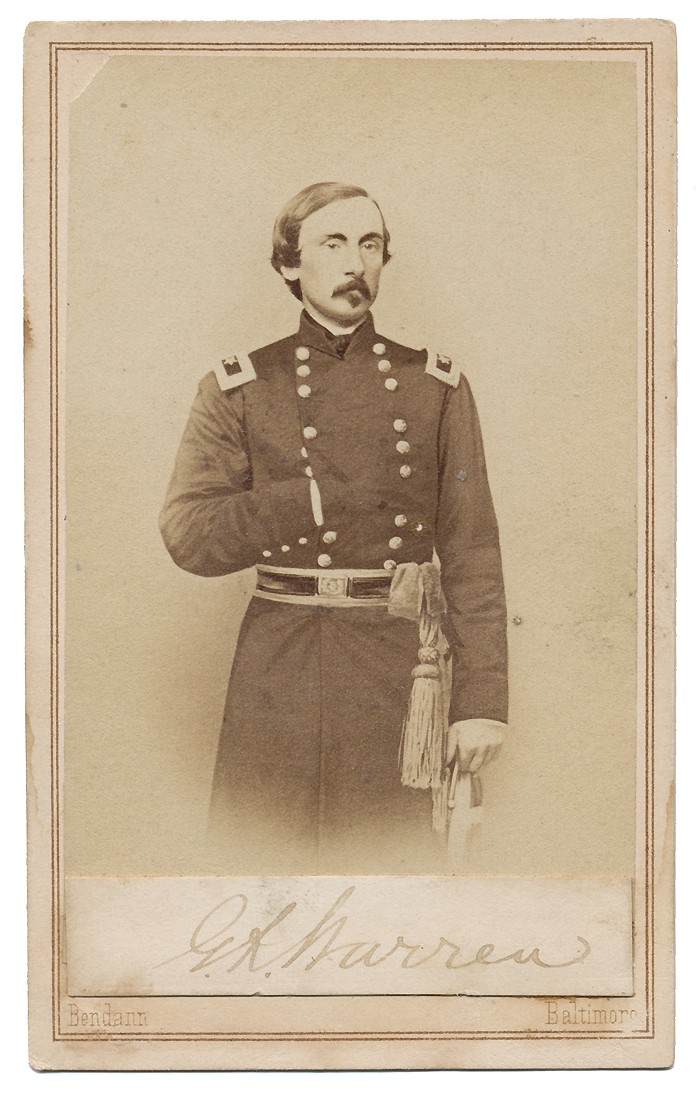site search
online catalog
INK ID STANDING VIEW OF MAJOR GENERAL G. K. WARREN - THE HERO OF LITTLE ROUND TOP - FROM THE BATCHELDER COLLECTION

Hover to zoom


$125.00 SOLD
Quantity Available: None
Item Code: 1094-143
CDV view of Gouverneur K. Warren in a classic Napoleonic pose. He wears a dark double-breasted frock coat with major general’s shoulder straps. Visible at his waist is his sword belt and sash.
Image is clear with good contrast. Paper and mount are good. Bottom left corner of the mount has light discoloration. Period ink ID at bottom reads “G. K. WARREN.”
Reverse has photographer’s imprint for BENDANN BROS…207 BALTIMORE ST. Old ink ID at top reads “GEN. WARREN AT GETTYSBURG.” Below in modern pencil is “FROM THE JOHN B. BATCHELDER COLLECTION” followed by the signature of a photo dealer with the date 8/93. At very bottom in pencil is GENL. WARREN.”
Gouverneur Kemble Warren was born January 8, 1830 in Cold Spring, Putnam County New York. He began his military career after graduating second in his class from the United States Military Academy at West Point in 1850. He was commissioned into the Corps of Topographical Engineers and spent time working along the Mississippi River, as well as taking part in creating one of the first comprehensive maps of the United States west of the Mississippi River.
After the outbreak of the Civil War, he was appointed Lieutenant Colonel of the 5th New York, and saw action at Big Bethel, Virginia on June 10, 1861. For his actions during the battle, he was promoted to Colonel of the regiment the following August. In 1862, he and his regiment took part in the Peninsula Campaign. Colonel Warren commanded his regiment during the Siege of Yorktown, and commanded a brigade of Sykes’ Division during the Seven Days Battles. He was wounded at the battle of Gaines’ Mill, and performed admirably at the Battle of Malvern Hill, holding off an attack of overwhelming Confederate forces. He commanded a brigade under Fitz John Porter at the Battle of Second Manassas and at Antietam. For his actions, he was promoted to Brigadier General of Volunteers on September 26, 1862 and continued to lead his brigade through the Battle of Fredericksburg. When the leadership of the Army of the Potomac changed in early 1863, Warren served as Chief Engineer for the new commanding officer, Major General Joseph Hooker. Warren held this position through the Battle of Chancellorsville and another change of command in late June during the Gettysburg Campaign when Major General George Gordon Meade took command of the army.
On the second day of the Battle of Gettysburg, General Warren realized the importance of the Little Round Top position which he found undefended. Warren quickly sent Colonel Strong Vincent’s brigade to hold the position just as Confederates began to attack. As a result of this action, the Union army was able to hold onto the key position, and went on to win the battle. Warren was promoted to Major General on August 8, 1863 following the campaign.
After Major General Winfield S. Hancock was wounded at Gettysburg, Warren took control of the 2nd Corps, and was noted for his actions during the Battle of Bristoe Station. During the Mine Run Campaign, Warren chose not to attack Lee’s army, avoiding a trap that would have cost many Union lives. Before Grant’s 1864 Campaign, Warren was reassigned to take command of the 5th Corps which he led through the famous “Overland Campaign,” the Siege of Petersburg and into the beginning stages of the Appomattox Campaign.
At the Battle of Five Forks, Union General Philip Sheridan was greatly angered by what he perceived as Warren moving his Corps too slowly, and relieved him of command on the spot. Although he was reassigned to the defenses of Petersburg, Warren would never forget the incident.
After the war, he resigned his commission as a Major General in protest to Sheridan’s actions, and returned to the Corps of Engineers. He spent the rest of his career attempting to exonerate his name. In 1879, a board of inquiry was finally called, and it was found that Sheridan was not justified in relieving Warren during the battle.
After the war Warren remained in the army and reverted to his pre-war rank of Major in the Corps of Engineers. He was assigned to railroad construction and duty in Mississippi. He was promoted to Lieutenant Colonel in 1879 but died at his duty station in Newport, Rhode Island on August 8, 1882. [ad]
~~~~~~~~~~~~~~~~~~~~~~~~~~~~~~~~~
THIS ITEM, AS WITH ALL OTHER ITEMS AVAILABLE ON OUR WEB SITE,
MAY BE PURCHASED THROUGH OUR LAYAWAY PROGRAM.
FOR OUR POLICIES AND TERMS,
CLICK ON ‘CONTACT US’ AT THE TOP OF ANY PAGE ON THE SITE,
THEN ON ‘LAYAWAY POLICY’.
THANK YOU!
Inquire About INK ID STANDING VIEW OF MAJOR GENERAL G. K. WARREN - THE HERO OF LITTLE ROUND TOP - FROM THE BATCHELDER COLLECTION
Most Popular
Historical Firearms Stolen From The National Civil War Museum In Harrisburg, Pa »
Theft From Gravesite Of Gen. John Reynolds »
Selection Of Unframed Prints By Don Troiani »
Fine Condition Brass Infantry Bugle Insignia »
Large English Bowie Knife With Sheath 1870’S – 1880’S »
Imported (Clauberg) Us Model 1860 Light Cavalry Officer's Saber »
featured item
CONFEDERATE SURGEON'S KEPI FOUND IN SOUTH CAROLINA
This cap was discovered in a Civil War period home in Charleston SC near "The Battery" neighborhood not many years ago. When found the cap needed a few minor repairs but it otherwise remains untouched as found and in marvelous condition! The body of… (1130-09). Learn More »


